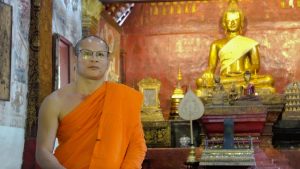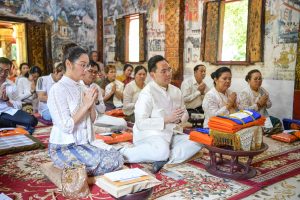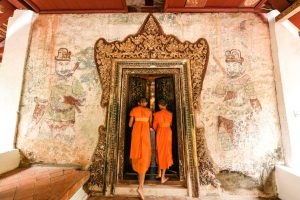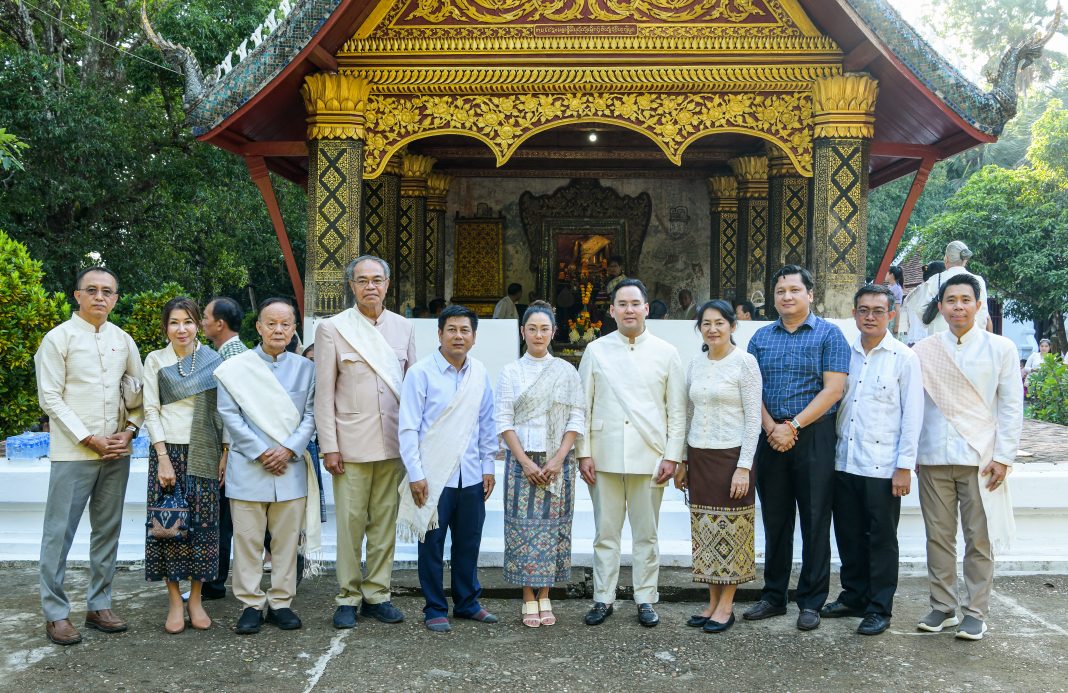In a display of commitment to cultural preservation and community engagement, Luang Prabang Power Company Limited took pride in co-hosting a traditional Kathin ceremony at Wat Longkhoun Srikhounnaram in the UNESCO World Heritage city of Luang Prabang.
This endeavor, which witnessed active participation from Luang Prabang Power Company Limited and well-known local pharmacy owner Bua Phan Duangduen, underscores the company’s unwavering dedication to go beyond the physical restoration of Wat Longkhoun and encompass the spiritual values embedded in the fabric of the Luang Prabang community.
Wat Longkhoun Srikhounnaram was established in 1791, during the reign of King Anurutha. It received monastic consecration in 1869. The overall design of Wat Longkhoun showcases exquisite mural paintings, while the front entrance features depictions of two Chinese warriors believed to protect the temple’s resident monks from malevolent spirits. Historically, the temple played a crucial role in preparing the Lan Xang King before ascending to the throne.
Prospective rulers were required to ordain and observe a period of monkhood at this temple for seven days. It is also the last temple where the revered Laos Sangharaja resided in meditation and seclusion before his passing, Phra Sombath Somepanno explained.

Phra Sombath Somepanno, abbot of Wat Longkhoun, emphasized the historical significance of this temple in the Buddhist heritage of Luang Prabang. Wat Longkhoun has a deep historical connection with Laos and the local monastic and lay communities, which have long been committed to the temple’s restoration. Their joint efforts prompted the initiation of the temple’s restoration in 2022, encompassing both the premises and its priceless ancient architecture.
Kathin ceremony
The Kathin ceremony, a traditional religious event where locals offer donations and orange robes to temples, typically marks an opportunity for both Lao and Thai Buddhists to contribute to the preservation of world heritage, maintaining its beauty in accordance with UNESCO standards.

A representative of Luang Prabang Power Company Limited said that the company and its employees are honored to have participated in the revered spiritual giving ceremony at Wat Longkhoun.
“Our involvement in this ancient tradition not only signifies our commitment to cultural preservation but also underscores our dedication to the enduring legacy of Luang Prabang. As a company deeply rooted in this historical city, we are proud to contribute not just during the almsgiving ceremony but to continuously support the local community in safeguarding the architectural marvels, traditions, and cultural heritage that make Luang Prabang a timeless treasure.”
Based on the gains of this year’s Kathin ceremony, the temple has devised comprehensive plans for the redevelopment of its premises, concentrating on seven critical areas. These include the construction of walls and fencing, relocating the kitchen away from the roadside, improving internal pathways, augmenting the number of trees, acquiring additional land for a meditation hall and accommodations with a dining area for practitioners, constructing a boundary fence around the monks’ residence area, and installing entrance gates to the temple. These endeavors play a pivotal role in preserving the temple’s status as a UNESCO World Heritage Site, aligning with the organization’s stringent standards.

Moreover, extending beyond the physical enhancements to Wat Longkhoun and its ancient architecture, there exist strategic initiatives to introduce regular meditation sessions for the local community and youth on weekends, and a summer novitiate program seeks to engage the younger generation in the teachings and practices of Buddhism.
Preserving cultural heritage
Luang Prabang has been a cultural world heritage city since December 1995.
UNESCO’s criteria for recognizing Luang Prabang as a cultural world heritage city revolve around three core principles. Firstly, the city must showcase architectural design and the conservation of monuments and landscapes, contributing to the continuous and influential development of cultural heritage. Secondly, it should feature prominent constructions serving as models for the advancement of culture, society, art, science, technology, and industry in human history. Lastly, Luang Prabang must embody distinguished human culture through architectural traditions, construction methods, or the establishment of human settlements susceptible to social and cultural changes over time.

To date, a total of 35 venues have earned registration as cultural world heritage sites in Luang Prabang, encompassing ancient temples, royal pavilions, and stupas.
The Lao government has demonstrated a significant commitment to the cultural heritage of Luang Prabang. This dedication is reflected in the appointment of a national and local-level world heritage committee tasked with establishing additional laws and regulations to ensure the proper care and preservation of this heritage in accordance with UNESCO standards.
Wat Longkhoun is registered as a cultural world heritage site, and the restoration project has received approval from UNESCO. The national and local world heritage committees have provided attentive support, assistance, and oversight to ensure that the temple’s reconstruction adheres to UNESCO standards throughout the process.



